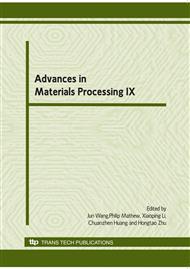p.189
p.195
p.201
p.207
p.213
p.219
p.227
p.232
p.238
Fabrication of a Large-Area Silicon Mold with Microstructures Using a Novel Recombining Technique
Abstract:
This paper presents an innovative fabrication of a large-area silicon mold with microstructures. Conventional techniques capable of manufacturing a large size mold pose severe challenges in making microstructures. In contrast, semiconductor process is limited in its wafer scale. This paper shows a new approach to achieve a large beyond-wafer-size silicon mold with alignment microstructures using two-direction passive alignment recombining techniques. Anisotropic bulk-micromachining technique, laterally joined of (111) silicon crystal planes, passive-alignment methods are the key to fabricate a large-area silicon mold. The area of each small silicon plate is 2.9cm2. Therefore, four small silicon plates with microstructures were recombined as a large-area square silicon mold. The optical fibers were placed into V-grooves on small silicon plates to make sure of microstructures alignment, minimum tilting and rotation angles between plates during the recombining process. The gap, height difference, and aligning accuracy of microstructures between joined silicon plates were able to achieve 8μm, 0.902μm and 20μm, respectively. Moreover, the rotation and tilting angles could be lowered to 0.0622 degree and 0.002 degree, respectively. Microstructures on the large-area silicon mold are faithfully reproduced by polydimethylsiloxane (PDMS). Finally, a 16.8 cm x 12.6 cm silicon mold was fabricated using twelve 4.2cm x 4.2cm silicon plates. It is believed that the novel technique will give an impact and create a highly value-added technology to the precise mold manufacturing.
Info:
Periodical:
Pages:
213-218
Citation:
Online since:
June 2010
Authors:
Keywords:
Price:
Сopyright:
© 2010 Trans Tech Publications Ltd. All Rights Reserved
Share:
Citation:


